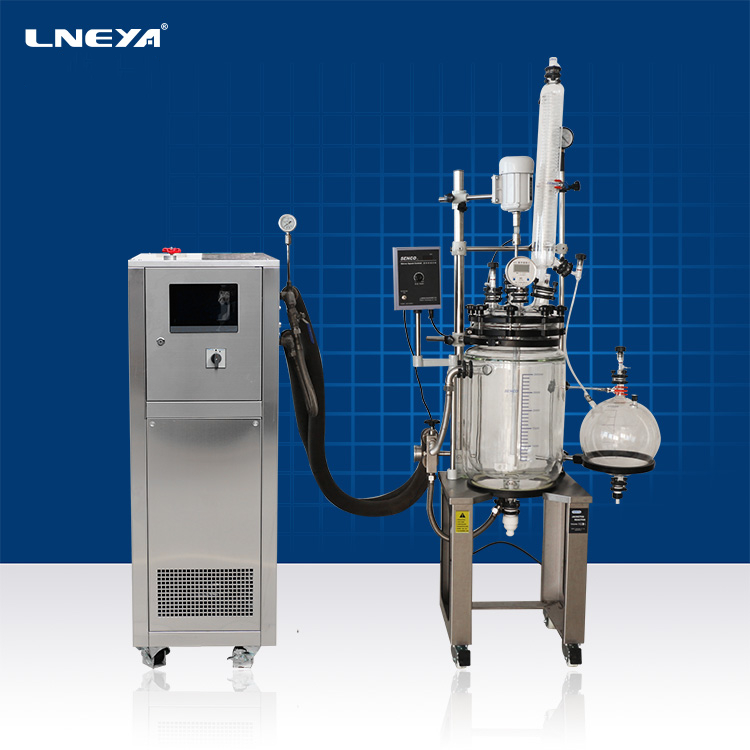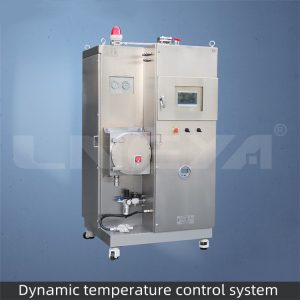Auswirkungen des Kühl- und Heizsystems auf den Glasreaktor
The glass reactor is compact in volume and clear in structure, and can be conveniently operated in series and parallel in a flexible manner, fully satisfying various process occasions; the reaction path does not have any metal contact, and the inlet and outlet ports use a special conical connector to facilitate the rapid connection of PTFE pipeline In addition, special import and export joints can also be customized according to specific needs. If you use LNEYA’s cooling and heating system equipment, you don’t have to worry about the size of the joint at all. We will match the joint according to your import and export flow.

The inner container of the double-layer glass reactor is equipped with reaction materials, and can be evacuated and speed-adjusted at the same time. The interlayer can introduce freezing liquid, water and high-temperature liquid to heat and cool the materials. It is used for synthesis of new materials in chemistry, fine chemicals and biopharmaceutical Wait for experiment, pilot and production. It can be combined with circulating water type multi-purpose vacuum pump, diaphragm vacuum pump, low temperature circulation (vacuum) pump, circulation cooler, constant temperature circulator, low temperature cooling liquid circulation pump, closed refrigeration heating circulation device, etc. to form a system device.
The temperature range of LNEYA cooling and heating system is -120 ℃ to 350 ℃, with high precision and intelligent temperature control. The ultra-high temperature cooling technology can directly cool down from the high temperature of 300 ℃. Since only the heat transfer medium in the expansion chamber is in contact with the oxygen in the air (the temperature of the expansion tank is between normal temperature and 60 ℃), the heat transfer medium can be reduced. High temperature heat medium will not evaporate at high temperature, and continuous control can be realized in the range of -80 ℃ to 190 ℃.
The glass reactor can be used in a large temperature range from high temperature (300℃) to low temperature (-80℃); it can work under normal pressure and vacuum conditions, and the vacuum degree can reach below 0.095MPa under static conditions. After the reaction of the interlayer cooling or heating solution, it can be completely eliminated without liquid accumulation. Choosing a good temperature control system equipment is inevitable for the reaction process and material testing.
Verwandte Empfehlungen
-
Entladungsvorgänge von Industriekühlern in Ammoniak-Kältesystemen
1043Der Gummischlauch, der zum Anschluss des Auslassventils verwendet wird, wird mit einem Ende in das Wasser des Wasserbehälters eingeführt. Wenn das Ammoniak im Mischgas zu Ammoniakflüssigkeit abgekühlt ist, gefriert der Boden des Luftabscheiders. Zu diesem Zeitpunkt, ...
Details anzeigen -
Betriebsanleitung für die Kältemaschine, ein Kreislaufsystem für die Temperierung von Laborprozessen
1062Das Wärmeträgermedium des Laborprozess-Temperaturregelkreislaufs verwendet Öl und Wasser. Das Wärmeträgermedium (Wärmeträgeröl oder Wasser), das in den Rohrleitungen zirkulieren muss, wird durch eine elektrische Heizung erwärmt...
Details anzeigen -
What Should Be Noticed In Detail When Installing A Precision Chiller?
1212First, when installation, everyone needs to check whether your cold water machine works normal, whether the accessories are all right, whether there is damage, so as to avoid problems in installation. Second, when installing, the site of the preci...
Details anzeigen -
Laboratory crystallization temperature control cooling and heating system
849In the laboratory crystallization process, temperature controlled cooling and heating system is a crucial component used to precisely control the temperature of the crystallization solution, in order to achieve high purity, specific morpho...
Details anzeigen
 LNEYA Industriekühler Hersteller Lieferant
LNEYA Industriekühler Hersteller Lieferant











